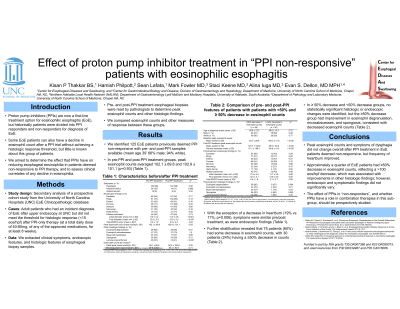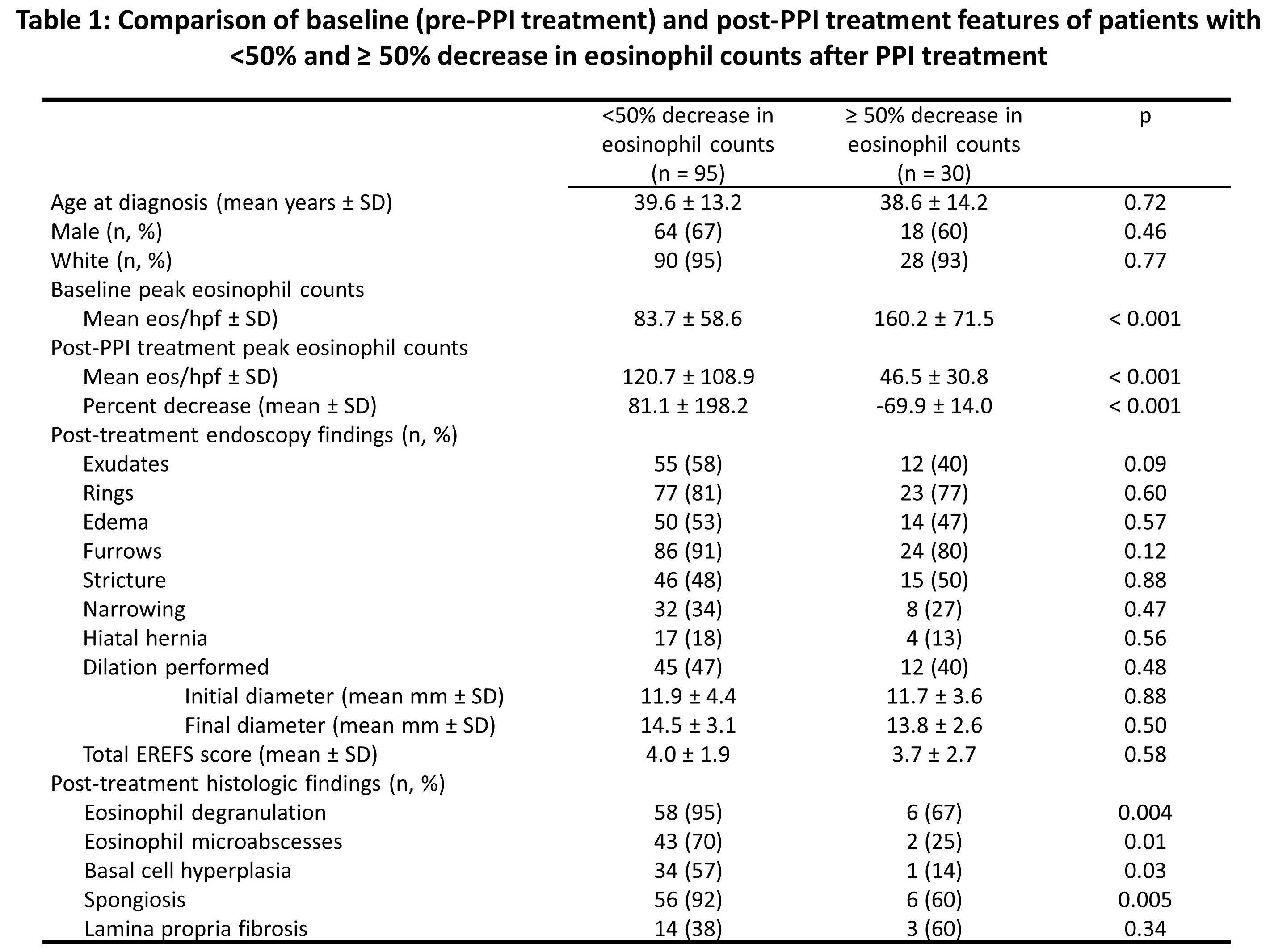Back

Poster Session D - Tuesday Morning
Category: Esophagus
D0204 - Effect of Proton Pump Inhibitor Treatment in “PPI Non-Responsive” Patients With Eosinophilic Esophagitis
Tuesday, October 25, 2022
10:00 AM – 12:00 PM ET
Location: Crown Ballroom

- ED
Evan Dellon, MD, MPH
University of North Carolina School of Medicine
Chapel Hill, North Carolina
Presenting Author(s)
Kisan Thakkar, BS1, Hamish Philpott, MBBS, MRCP, PhD2, Sean LaFata, BS1, Mark Fowler, MD1, Staci Keene, MD1, Alina Iuga, MD1, Evan Dellon, MD, MPH1
1University of North Carolina School of Medicine, Chapel Hill, NC; 2University of Adelaide, Adelaide, South Australia, Australia
Introduction: EoE patients were historically divided into proton pump inhibitor (PPI) responders and non-responders for diagnosis. We observed that some EoE patients have a decline in eosinophil count after PPI treatment without achieving histologic response, but little is known about this group of patients. We aimed to determine the effect of PPIs on reducing esophageal eosinophilia in patients deemed non-responsive to PPIs.
Methods: We analyzed a prospective cohort of adults with an incident diagnosis of EoE at University of North Carolina, but who did not meet the threshold for histologic response (< 15 eos/hpf) after PPI-only therapy (total daily dose of 40-80mg of any of the approved medications for ≥8 weeks). Symptoms, endoscopic features, and histologic features were recorded. Pre- and post-PPI treatment esophageal biopsies were re-read by pathologists to determine peak eosinophil counts and other histologic findings. We compared eosinophil counts and response metrics between these groups.
Results: We identified 125 PPI “non-responsive” EoE patients with pre- and post-PPI samples available (mean age 39 years; 66% male; 94% white). Peak pre- and post-PPI treatment eosinophil counts were 102.1 ± 69.8 and 102.9 ± 101.1 (p=0.93); counts did not decrease by proximal or distal locations, and associated histologic findings were similar pre/post treatment, apart from a decrease in lamina propria fibrosis (p< 0.001). With the exception of a decrease in heartburn (19% vs 11%; p=0.006), symptoms were similar pre/post treatment, as were endoscopic findings. However, 75 patients (60%) had some decrease in eosinophil count while 30 patients (24%) had ≥50% decrease in counts. When comparing the ≥50% decrease and < 50% decrease groups, clinical, endoscopic, and histologic features were similar at baseline and post-PPI, but the ≥50% decrease group had significant improvement in eosinophil degranulation, microabscesses, and spongiosis (Table 1).
Discussion: Peak eosinophil counts and dysphagia did not change overall after PPI treatment in EoE patients deemed PPI non-responsive, but frequency of heartburn improved. Approximately a quarter of EoE patients had ≥50% decrease in eosinophil counts, reflecting a >100 eos/hpf decrease, which was associated with improvements in other histologic findings. The effect of PPIs in “non-responders”, and whether PPIs have a role in combination therapies in this sub-group, should be prospectively studied.

Disclosures:
Kisan Thakkar, BS1, Hamish Philpott, MBBS, MRCP, PhD2, Sean LaFata, BS1, Mark Fowler, MD1, Staci Keene, MD1, Alina Iuga, MD1, Evan Dellon, MD, MPH1. D0204 - Effect of Proton Pump Inhibitor Treatment in “PPI Non-Responsive” Patients With Eosinophilic Esophagitis, ACG 2022 Annual Scientific Meeting Abstracts. Charlotte, NC: American College of Gastroenterology.
1University of North Carolina School of Medicine, Chapel Hill, NC; 2University of Adelaide, Adelaide, South Australia, Australia
Introduction: EoE patients were historically divided into proton pump inhibitor (PPI) responders and non-responders for diagnosis. We observed that some EoE patients have a decline in eosinophil count after PPI treatment without achieving histologic response, but little is known about this group of patients. We aimed to determine the effect of PPIs on reducing esophageal eosinophilia in patients deemed non-responsive to PPIs.
Methods: We analyzed a prospective cohort of adults with an incident diagnosis of EoE at University of North Carolina, but who did not meet the threshold for histologic response (< 15 eos/hpf) after PPI-only therapy (total daily dose of 40-80mg of any of the approved medications for ≥8 weeks). Symptoms, endoscopic features, and histologic features were recorded. Pre- and post-PPI treatment esophageal biopsies were re-read by pathologists to determine peak eosinophil counts and other histologic findings. We compared eosinophil counts and response metrics between these groups.
Results: We identified 125 PPI “non-responsive” EoE patients with pre- and post-PPI samples available (mean age 39 years; 66% male; 94% white). Peak pre- and post-PPI treatment eosinophil counts were 102.1 ± 69.8 and 102.9 ± 101.1 (p=0.93); counts did not decrease by proximal or distal locations, and associated histologic findings were similar pre/post treatment, apart from a decrease in lamina propria fibrosis (p< 0.001). With the exception of a decrease in heartburn (19% vs 11%; p=0.006), symptoms were similar pre/post treatment, as were endoscopic findings. However, 75 patients (60%) had some decrease in eosinophil count while 30 patients (24%) had ≥50% decrease in counts. When comparing the ≥50% decrease and < 50% decrease groups, clinical, endoscopic, and histologic features were similar at baseline and post-PPI, but the ≥50% decrease group had significant improvement in eosinophil degranulation, microabscesses, and spongiosis (Table 1).
Discussion: Peak eosinophil counts and dysphagia did not change overall after PPI treatment in EoE patients deemed PPI non-responsive, but frequency of heartburn improved. Approximately a quarter of EoE patients had ≥50% decrease in eosinophil counts, reflecting a >100 eos/hpf decrease, which was associated with improvements in other histologic findings. The effect of PPIs in “non-responders”, and whether PPIs have a role in combination therapies in this sub-group, should be prospectively studied.

Figure: Comparison of baseline (pre-PPI treatment) and post-PPI treatment features of patients with <50% and ≥ 50% decrease in eosinophil counts after PPI treatment
Disclosures:
Kisan Thakkar indicated no relevant financial relationships.
Hamish Philpott indicated no relevant financial relationships.
Sean LaFata indicated no relevant financial relationships.
Mark Fowler indicated no relevant financial relationships.
Staci Keene indicated no relevant financial relationships.
Alina Iuga indicated no relevant financial relationships.
Evan Dellon: Abbott, Abbvie, Adare/ Ellodi, Aimmune, Akesobio, ALK, Allakos, Amgen, Arena, Aslan, AstraZeneca, Avir, Biorasi, Calypso, Celgene/Receptos/BMS – Consultant. Adare/Ellodi, Allakos, Arena, AstraZeneca, GSK, Meritage, Miraca, Nutricia, Celgene/Receptos/BMS, Regeneron, Revolo, Shire/Takeda – Grant/Research Support. Allakos, Banner, Holoclara – educational grant. Celldex, Eli Lilly, EsoCap, Eupraxia, GSK, Gossamer Bio, Invea, Landos, LucidDx, Morphic, Nutricia – Consultant. Parexel/Calyx, Phathom, Regeneron, Revolo, Robarts/Alimentiv, Salix, Sanofi, Shire/Takeda, Target RWE – Consultant.
Kisan Thakkar, BS1, Hamish Philpott, MBBS, MRCP, PhD2, Sean LaFata, BS1, Mark Fowler, MD1, Staci Keene, MD1, Alina Iuga, MD1, Evan Dellon, MD, MPH1. D0204 - Effect of Proton Pump Inhibitor Treatment in “PPI Non-Responsive” Patients With Eosinophilic Esophagitis, ACG 2022 Annual Scientific Meeting Abstracts. Charlotte, NC: American College of Gastroenterology.
